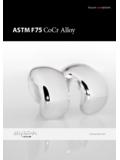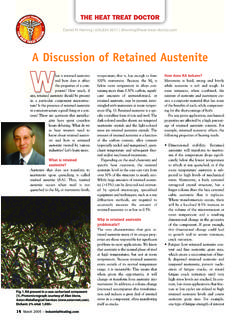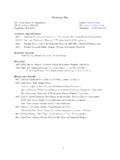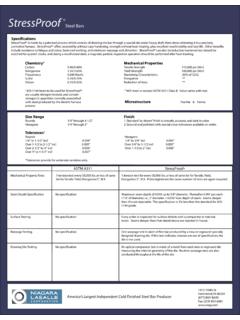Transcription of V. B. da Trindade Filho et al Normalizing Heat Treatment ...
1 V. B. da Trindade Filho et al / Vol. XXVI, No. 1, January-March 2004 ABCM 62 V. B. da Trindade Filho A. S. Guimar es and J. da C. Pay o Filho Universidade Federal do Rio de Janeiro CT, Enga Metal rgica e de Materiais Box Cidade Universit ria, Ilha do Fund o 21941-972 Rio de Janeiro, RJ. Brazil and R. P. da R. Paranhos Universidade Estadual do Norte Fluminense Centro de Ci ncia e Tecnologia Laborat rio de Materiais Avan ados Av. Alberto Lamego 2000, Parque Calif rnia 28015-620 Campos dos Goytacases, RJ Brazil Normalizing Heat Treatment Effect on Low Alloy Steel Weld Metals In equipment manufacturing, there are occasions that the base metal (BM) need to be hot or cold worked prior to welding.
2 After welding, the components have to be submitted to a Normalizing heat Treatment in order to recover its original mechanical properties. In this work four different low alloy steel weld metals (WM) both in the as welded condition and after Normalizing heat Treatment have been studied. Optical and scanning electron microscopy were used to observe the WM microstructure. Tensile and Charpy V toughness testing and microhardness measurements were used to evaluate the WM mechanical properties.
3 Results show that Normalizing breaks the original columnar structure in the as welded condition to an equiaxial structure similar to the one of the BM. Due to low carbon content of the WM it was observed a high decrease on the tensile properties specially the yield strength after Normalizing . In respect of toughness, the Normalizing heat Treatment was observed to increase the Charpy V energy, except for one WM where a great content of martensite-austenite-bainite constituent was formed. Opposite to others post weld heat treatments, Normalizing modifies significantly the microstructure and the resulting mechanical properties of the WM.
4 Although Normalizing is always beneficial to the BM, care must be taken in order to select welding consumables. Keywords: Welding, low alloy steel weld metal, Normalizing heat Treatment Introduction The weld metal metallurgy for C-Mn and low alloy steels differs significantly from the base metal metallurgy in several aspects: heating and cooling rates of a weld are much more faster than those of a steel base metal during its manufacturing process; the microstructure of the weld metal is columnar and as melted, and it was not submitted to any subsequent thermo-mechanical Treatment .
5 Weld metal carbon content is usually kept below , while C-Mn and low alloy structural steels have ; it is observed that C-Mn and low alloy steel weld metal microstructure is a complex mixture of two or more constituents, such as proeutectoide ferrite, polygonal ferrite, aligned and non-aligned side plate ferrite, ferrite-carbide aggregate and acicular ferrite (IIW, 1988). When alloying elements are added to the weld metal, upper and lower bainite, martensite and the A-M (austenite with martensite) microconstituent may be formed (Grong, 1992; Evans, 1991); tensile properties of the weld metal are relatively high when compared to those of a base metal of similar chemical The manufacturing of equipments by welding usually requires cold forming and for few cases hot forging of steel plates in order that they acquire specific shapes.
6 When working with thick plates, welding generates a high level of residual stresses, and it is usual to perform a stress relieve heat Treatment after welding. This is always done at temperatures between 600 C-700 C, well below Ac1, and therefore it does not change significantly the microstructure and mechanical properties of both base and weld metals. In some few cases, when the steel is hot or cold worked, it is necessary to perform a Normalizing heat Treatment in order to recover its original mechanical properties. As Normalizing involves heating above Ac3 in order to promote the base metal grain refinement, this will change the original characteristics of an as welded structure.
7 The effect of Presented at COBEF 2003 II Brazilian Manufacturing Congress, 18-21 May 2003, Uberl ndia, MG. Brazil. Paper accepted October, 2003. Technical Editor: Alisson Rocha Machado the Normalizing heat Treatment on the weld metal microstructure has not been yet well studied on the literature. The present work has as objective the evaluation of the microstructure and mechanical properties of C-Mn and low alloy steel weld metals after Normalizing heat Treatment . Experimental Procedure Four all weld metal joints were made with submerged-arc welding, and the adopted welding procedure was according to AWS As consumables, it was used a neutral flux and four different wires: CMn ( ), CMnMo ( , ), CMnMoCr ( , , ) and CMnMoTiB ( , , , ).
8 Table 1 shows the welding parameters used. Table 1. Welding parameters and data. Parameter Data Welding current 550 A Type of current CC+ Voltage 28 V Welding speed 40 cm/min Number of beads 17 Interpass temperature 163oC Welding time 80 s Wire diameter mm Groove opening 16 mm Heat input kJ/mm Backing Steel The Normalizing heat
9 Treatment was made heating the welding joints at a rate of 200 C/h from ambient temperature up to 920 C and remained at this temperature for 2h. Afterwards, they were removed from the oven and air cooled up to the ambient temperature. Quantitative metallography was carried out only on the weld metals in the as welded condition. Samples were etched with Normalizing Heat Treatment Effect on Low Alloy Steel Weld Metals J. of the Braz. Soc. of Mech. Sci. & Eng. Copyright 2004 by ABCM January-March 2004, Vol.
10 XXVI, No. 1 / 63nital 2%, and image acquisition was performed with 500x magnification at 30 different fields in the columnar zone (last weld bead). It was used a grid of 42 points for each sample (Voort and George, 1984). IIW DOC IX-1533-88 (IIW, 1988) was used to identify and classify the weld metal microstructure. For the normalized condition the average ferrite grain size was measured by the intercept method. The ASTM number was calculated according to the Voort equation (Voort and George, 1984).
















